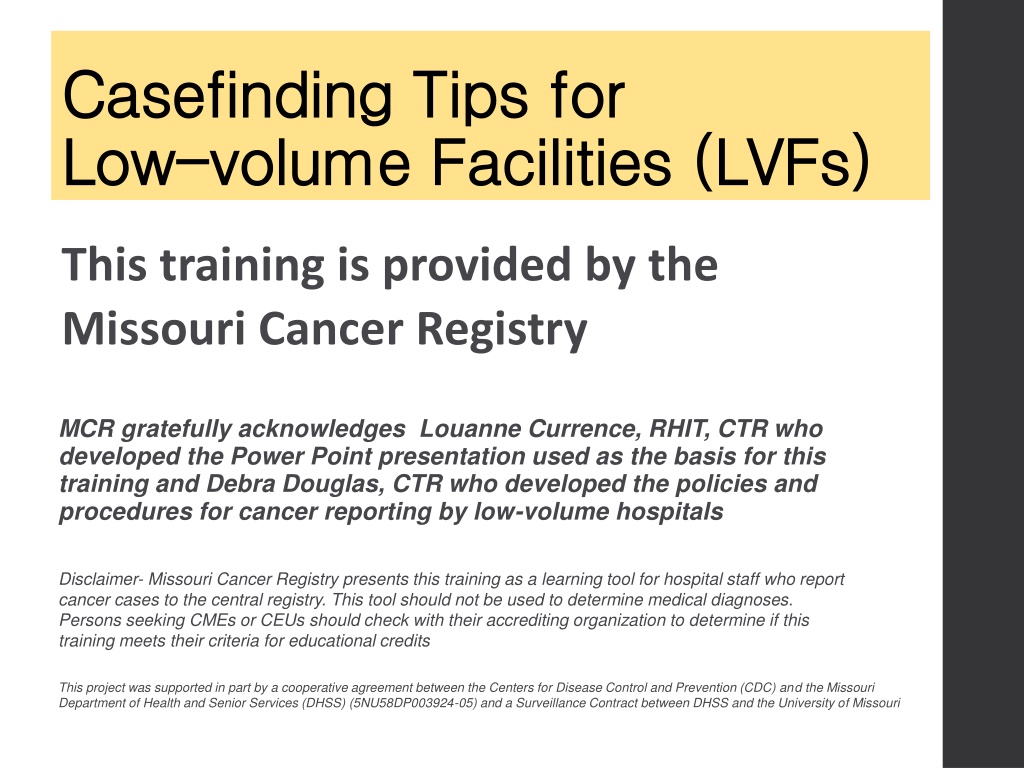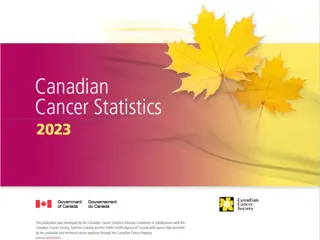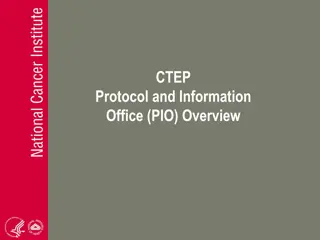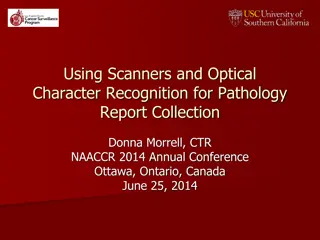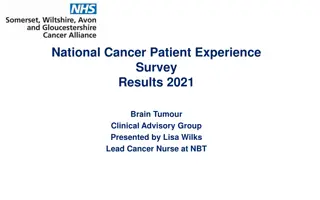Tips for Low-Volume Facilities in Cancer Casefinding
This training provided by the Missouri Cancer Registry covers laws, regulations, and procedures for reporting cancer cases from low-volume facilities. It emphasizes the importance of identifying, copying, and submitting relevant medical records for abstraction by registry staff, along with timely case submissions to ensure compliance with reporting requirements.
Download Presentation

Please find below an Image/Link to download the presentation.
The content on the website is provided AS IS for your information and personal use only. It may not be sold, licensed, or shared on other websites without obtaining consent from the author.If you encounter any issues during the download, it is possible that the publisher has removed the file from their server.
You are allowed to download the files provided on this website for personal or commercial use, subject to the condition that they are used lawfully. All files are the property of their respective owners.
The content on the website is provided AS IS for your information and personal use only. It may not be sold, licensed, or shared on other websites without obtaining consent from the author.
E N D
Presentation Transcript
Casefinding Casefinding Tips for Low Low- -volume Facilities (LVFs) volume Facilities (LVFs) Tips for This training is provided by the Missouri Cancer Registry MCR gratefully acknowledges Louanne Currence, RHIT, CTR who developed the Power Point presentation used as the basis for this training and Debra Douglas, CTR who developed the policies and procedures for cancer reporting by low-volume hospitals Disclaimer- Missouri Cancer Registry presents this training as a learning tool for hospital staff who report cancer cases to the central registry. This tool should not be used to determine medical diagnoses. Persons seeking CMEs or CEUs should check with their accrediting organization to determine if this training meets their criteria for educational credits This project was supported in part by a cooperative agreement between the Centers for Disease Control and Prevention (CDC) and the Missouri Department of Health and Senior Services (DHSS) (5NU58DP003924-05) and a Surveillance Contract between DHSS and the University of Missouri
There are several Missouri laws about There are several Missouri laws about cancer reporting cancer reporting Missouri Cancer Registry (MCR) Regulations Reporting of cancer cases to the Missouri Department of Health (now the Missouri Department of Health and Senior Services) for Missouri hospitals became mandatory in 1984 when the State General Assembly passed a bill to require inpatient reporting by hospitals Due to changes in the health care delivery system, an increasing number of cancer cases are now being treated outside the hospital setting Therefore an expanded cancer reporting law was passed in 1999 This law requires that pathology laboratories, ambulatory surgery centers, freestanding cancer clinics and treatment centers, physicians and long-term care facilities also report cancer cases
The laws are applied to low The laws are applied to low- -volume facilities as follows: facilities as follows: volume A hospital with 50 or fewer cases annually is classified as low-volume Low-volume facilities: Identify potential cases, copy and submit relevant parts of the medical record for abstraction by central registry staff Submit cases on a quarterly basis Submit cases to MCR within 6 months of patient s initial contact with the facility
The main role of low The main role of low- -volume hospitals is casefinding casefinding & submitting charts in a & submitting charts in a complete and timely fashion complete and timely fashion volume hospitals is By law, facilities are required to report cases diagnosed and/or treated for cancer in their facility Unlike larger hospitals, low-volume hospitals are not required to submit fully-abstracted cases electronically Related duties involve keeping complete records of cases submitted, correspondence from MCR, etc.
Casefinding Casefinding basics basics Designate a specific person to perform casefinding and allow adequate time to identify cases, copy and submit charts Conduct casefinding activities on a regular basis at least quarterly Collaborate with the laboratory and other departments/sources that may provide tumor information
How do I identify How do I identify reportable cases? reportable cases?
Reportable Cases Reportable Cases - - Inpatient and outpatient hospital cases are required Inpatient and outpatient hospital cases are required - - Cases with specified ICD Cases with specified ICD- -10 codes 10 codes In order to report a case to MCR, you first must be able to determine if a case is eligible Case eligibility is usually determined by a combination of factors, which include the behavior of the disease (benign, malignant, in situ, etc.), and when and where the case is treated Look in the MCR Abstract Code Manual or on the MCR website for a reportable list of the ICD-10 codes (https://medicine.missouri.edu/centers-institutes- labs/cancer-registry-research-center/reporting/hospital) The following slides discuss different aspects of how to determine if you should report a case to MCR
If your facility owns the medical If your facility owns the medical record you should report the case! record you should report the case! The general rule of thumb is that the hospital that owns the medical record where the patients diagnosis and/or treatment occurs is the facility required to report the case For many low-volume facilities, the patient will be diagnosed in your facility, but referred elsewhere for treatment Examples: A patient has a mammogram at your hospital and the radiologists says the test is suspicious for breast cancer. The patient is referred to another hospital for the biopsy. This case is reportable A patient has a colonoscopy at a surgery center owned by the hospital. The test shows cancer. This case is reportable A patient is diagnosed with prostate cancer by a prostate biopsy performed in a physicians office whose practice is owned by your hospital. This case is reportable
ICD ICD- -10 exclusions exclusions 10- -CM inclusions and CM inclusions and While the ICD-10-CM list mainly includes malignancies, there are a few inclusions and exclusions you need to know
Inclusion: Benign brain tumors Inclusion: Benign brain tumors ARE ARE reportable reportable Beginning with cases diagnosed in 2004 benign brain tumors are required to be reported to MCR Codes for benign brain tumors that must be reported are: ICD-10-CM Codes D32.0 D32.9(for Benign Meninges and Brain) D33.0 D33.9 (for Spinal Cord, Cranial Nerves and other) D35.2 D35.4 (for other endocrine glands, etc.)
Exclusions: Some malignant Exclusions: Some malignant tumors are tumors are NOT NOT reportable reportable MCR does not require Basal Cell Carcinomas (BCC) and Squamous Cell Carcinoma (SCC) of the skin are no longer required to be reported This includes ICD-10-CM codes C44.x1 and C44.x2 skin cancers CIN (cervix) ICD-10-CM D06.0-D06.0-D06.9 PIN (prostate) ICD-10-CM D07.5
Tricky cases!! Tricky cases!! Cases of intraepithelial neoplasia can be tricky MCR does require intraepithelial neoplasia for all AIN (anal) ICD-10-CM code D12.9 Female Genital Organs N89-90 233.32 which includes VIN (vulvar) and VAIN (vaginal) and
Tricky cases!! Tricky cases!! Recent audits by MCR have revealed that we have not provided enough training on casefinding for certain sites The diseases listed on the next few slides may not sound like cancer, may not be pathologically diagnosed, or may be seen at your facility for treatment other than surgery and chemotherapy
Tricky cases!! Tricky cases!! Special attention is needed so as not to miss the following types of reportable cases: Lung, pancreas and brain cancers diagnosed only by imaging reports. Patient refuses work-up or is referred elsewhere. This is your case because it was diagnosed via imaging. Sometimes these are Emergency Department visits Diagnostic mammograms if report states suspicious for malignancy , not just BIRADS 4 or 5 Digital rectal exam if report states suspicious for cancer or suspicious for malignancy Hormone treatment for prostate (Lupron shots, etc) or breast cancer (oral tamoxifen, aromatase inhibitors, etc)
Tricky cases!! Tricky cases!! Special attention is needed so as not to miss the following types of reportable cases: Diagnosis of a cancer recurrence or metastasis (by biopsy or imaging) on a case not previously reported Instillation of BCG during cystoscopy Phlebotomy treatment for polycythemia vera if diagnosed after 2001 Aspirin or Anagrelide treatment for essential thrombocythemia if diagnosed after 2001 Clinical diagnosis of Myelodysplastic Syndrome or various Refractory Anemias (may also have bone marrow biopsy) if diagnosed after 2001
Some terms used in reporting cases Some terms used in reporting cases can be ambiguous can be ambiguous Terms that designate a reportable case must always include a reference to malignancy, cancer or other similar term, except when the diagnosis is for a benign primary tumor of the intracranial region, the brain or the central nervous system Some specific ambiguous terms that are used by physicians constitute a reportable diagnosis, while others do not These terms may originate from any source document such as pathology, radiology, discharge summary and clinical reports and may lead to minor problems during casefinding as some ambiguous terms for ICD-10 coding may not mean the same thing regarding reporting status (i.e.: possible cancer may be coded as a malignancy by ICD-10 coders, but possible is a non-reportable ambiguous term for cancer reporting) When reviewing the medical record, if ambiguous terminology is used in the diagnosis, refer to the following list to determine reporting status
Some terms used in reporting test Some terms used in reporting test results can be ambiguous results can be ambiguous If one of the following terms is used by the physician (in combination with malignancy or cancer ), the case is reportable: apparently compatible with neoplasm* probable typical of appears consistent with most likely suspect (ed) tumor* comparable with favors presumed suspicious (for) * Additional terms for nonmalignant primary intracranial and central nervous system tumors only On the other hand, if one of these terms is used, the case is NOT reportable: cannot be ruled out potentially malignant suggests equivocal questionable worrisome possible rule out
Examples of ambiguous terminology Examples of ambiguous terminology CT scan results state cancer cannot be ruled out This is NOT reportable CT scan results state probable cancer This IS reportable
What sources do I use What sources do I use to identify cases? to identify cases?
Common places to look for Common places to look for reportable cases include: reportable cases include: Medical Records/HIM departments: These departments can produce lists based on the patient s diagnosis (ICD-10 codes) and/or the type of procedure done for the patient (ICD-10- PCS codes). These lists are commonly called medical records disease indices (MRDI) Laboratory reports: Pathology reports from surgical procedures are a good source. Cytology reports from urine, sputum, fluids such as spinal, pleural, ascites, etc. are also good sources to use when looking for reportable cases. Pap tests are considered cytology, but MCR does not require results from those procedures Outpatient department lists:Patient lists from outpatient sites such as same day surgery clinics, satellite clinics, etc. can provide possible reportable cases. Clinic charts must be reviewed at least annually, but it may be easier to do it more often (monthly or quarterly)
Using the medical record disease Using the medical record disease index (MRDI) to locate cases index (MRDI) to locate cases The MRDI is one of the most complete sources to locate reportable cases. It must be designed to include codes to identify all potential cases based on ICD-10-CM DIAGNOSIS CODES For each admission of the patient include THE TOP SIX ICD-10 CODES (see MCR Abstract Code Manual or the MCR website for list of reportable codes) and reviewed on a regular basis (at least quarterly) Do not rely on non-specific activities such as discharge lists, memory or charts being identified by coders The report should be designed to include patient name, date of birth, ICD-10-CM codes, procedure codes, admission type and medical record number and sorted by patient name If your department does not have the capability to generate the report, request assistance from your hospital s IT department
Using the pathology report to Using the pathology report to locate cases locate cases The use of pathology reports will identify patients diagnosed and or treated at your facility Collaborate with staff in the pathology department to route copies of all path reports that mention a reportable diagnosis Provide pathology department personnel with the necessary information to identify cancer cases Some facilities may have electronic pathology records that could be used to produce regular reports
Other sources Other sources If the hospital owns the records: Outpatient listings Same-day surgery centers Satellite clinics ***Occasionally you will run across a chart that provides evidence of a diagnosis in a physician s office. Cases generated by a patient having been seen in a physician s office NOT owned by the hospital are not your responsibility to report unless contracted to do so for them
Potential sources Potential sources (continued) (continued) Other potential sources: Specialty procedures for patients should have a special procedure code. You should be able to ask for them to be reported on the MRDI Colonoscopy and EGD endoscopy Bronchoscopy Orchiectomy Biopsies and excisional surgeries Chemo infusion Radiation therapy
Potential sources Potential sources (continued) (continued) Less common, but effective, places to look for reportable cases include: HIM procedure lists Orchiectomies Mammograms that lead to biopsy X-rays
What constitutes a What constitutes a diagnosis? diagnosis?
A diagnosis includes: A diagnosis includes: Positive pathology reports - examination of tissue and blood Tissue specimens - incisional biopsy, excisional biopsy, surgical resection, autopsy and D&C Bone Marrow biopsy aspiration and biopsy For leukemia only Peripheral blood smears, CBCs, WBCs
What constitutes a diagnosis? What constitutes a diagnosis? Positive cytology reports - examination of cells Bronchial brushings and washings, sputum smears, pleural fluid, peritoneal fluid, spinal fluid, gastric fluid, cervical and vaginal smears, urinary sediment (Pap tests are considered cytology, but MCR does not require results from those procedures)
Diagnosis continued: Diagnosis continued: Positive radiology tests these tests may contain ambiguous terminology & may require additional manpower for review Mammograms Chest x-rays CT scans MRIs Ultrasound
How do you define How do you define treatment? treatment?
Definition of treatment Definition of treatment Treatment or therapy for cancer modifies, controls, removes or destroys cancer tissue The first course of treatment includes all cancer-directed treatments indicated in the initial treatment plan which are actually delivered to the patient A decision not to treat or refusal by the patient to accept treatment is considered a treatment plan, as is palliative care These patients are all reportable to MCR
Examples of treatment Examples of treatment Reportable During a colonoscopy at another facility a patient is diagnosed with colon cancer. The patient has a part of the colon removed at your facility The patient is admitted to your facility during a course of chemotherapy for low blood counts. During the hospital stay, the patient receives chemotherapy
Exclusions Exclusions these are not these are not reportable: reportable: Not reportable A patient is diagnosed with colon cancer at another hospital. He comes to your facility for a follow-up annual colonoscopy that is negative A patient is receiving chemotherapy at another hospital/facility. Due to complications or another health condition, the patient is hospitalized at your facility The patient is coded as having a history of cancer in ICD-10 Your facility is caring for a patient who has active or metastatic cancer but is not receiving treatment but may be receiving hospice care at your facility
Keeping track of your Keeping track of your findings: findings:
Keeping track Keeping track A Control Log of charts that have been submitted to MCR must be maintained This log should include: Patient name Date of birth Social security number Reporting year ICD-10 codes Encounter date(s) Date submitted to MCR
Other documentation Other documentation Copies of pathology reports, new patient listings, end of treatment notes, monthly/quarterly disease index and other logs and discrepancy files may be maintained as desired by the facility All casefinding files should be secured per HIPAA regulations to prevent unauthorized access to patient information
Use of a non Use of a non- -reportable list reportable list To further assist with casefinding activities and possibly eliminate the need to pull a chart multiple times, a non- reportable list can be maintained. This is a list of cases that have been reviewed and found to be non-reportable This list should include: Patient name Date of birth or social security number Encounter date(s) ICD-10 codes Brief reason case is non-reportable
Summary: Summary:
Key elements to remember Key elements to remember Identify potentially reportable patients 1. Locate the charts and other data 2. Review for reporting status 3. Copy pertinent chart documents for reportable cases 4. Transmit the data to MCR at least quarterly 5. Maintain control log and non-reportable log 6.
Review Review Casefinding should be considered a priority of the Health Information Management (or other designated) department A specific person should be designated to perform case- finding. That person should be given adequate time to identify, copy and submit charts Casefinding activities must be conducted on a regular basis (at least quarterly) MCR must be informed of any staff turnover or changes by submitting a Hospital Directory Update Form https://medicine.missouri.edu/centers-institutes-labs/cancer-registry- research-center/reporting and Web Plus Contact Form https://medicine.missouri.edu/centers-institutes-labs/cancer-registry- research-center/reporting/web-plus when applicable.
And lastly... And lastly... A Transmittal Form must be submitted for each reporting period (quarterly) even if no charts are being sent https://medicine.missouri.edu/centers-institutes- labs/cancer-registry-research-center/reporting Please contact MCR if data submission for any reporting period is going to be late Call MCR at 1-800-392-2829 with questions we re glad to help! https://medicine.missouri.edu/centers-institutes- labs/cancer-registry-research-center
